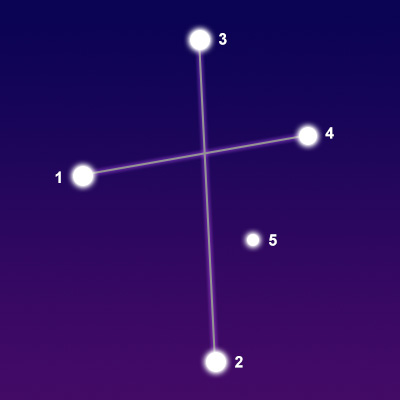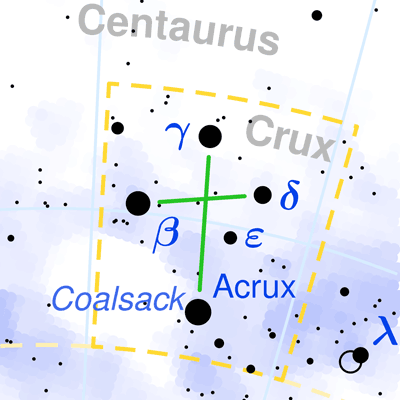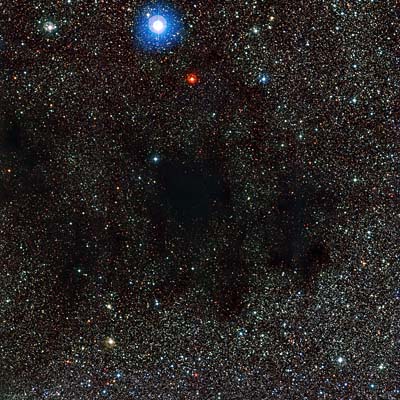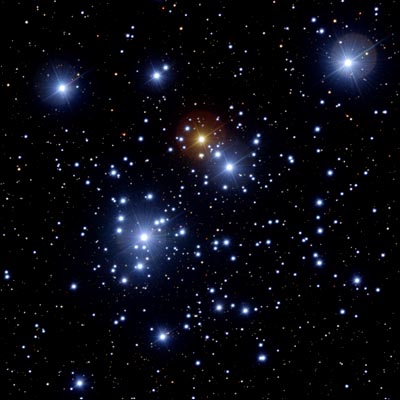Pronunciation:
(KRUKS)Abbreviation:
CruGenitive:
CrucisRight Ascension:
12 hoursDeclination:
-60 degreesArea in Square Degrees:
68Crosses Meridian:
9 PM, May 10Visible Between Latitudes:
20 and -90 degreesThe constellation Crux, the southern cross, is a constellation in the southern hemisphere of the sky. It is only visible from latitudes south of 27 degrees. It is completely below the horizon in most parts of the northern hemisphere. It is the smallest constellation in the night sky with a total area of only 68 square degrees. It is bordered by the constellations Centaurus on the east, north and west, and Musca to the south. Crux is one of the most familiar constellations in the southern hemisphere. It is an easy constellation to identify, due to its obvious cross shape and bright stars. Since the southern hemisphere does not have a bright star near its pole, Crux was used by sailors as a navigational aid. They would draw a line using the stars in the cross in order to determine the location of the south celestial pole, which is actually located in the constellation Ocatans.
Crux was considered to be part of the constellation Centaurus by the Greek astronomer Ptolemy in the second century. The Greeks were able to see the celestial cross before it disappeared below the horizon due the procession of the Earth’s axis. Some linked the disappearance of the cross with the crucifixion of Christ. By the year 400, the stars were no longer visible from Europe. The Dutch astronomer Petrus Plancius was the first to separate the stars into their own constellation in 1592. The Southern Cross carried special significance for many cultures in the southern hemisphere. The ancient Inca knew the constellation as Chakana, which means “the stair”. The Mori called it Te Punga, which meant “the anchor.” To the ancient aboriginal people of Australia, it represented part of the head of the Emu in the Sky. It is represented on the Australian flag and on the flag of Brazil.

points of interest below © Sea and Sky

© Torsten Bronger CC BY-SA 3.0
Mimosa
Gacrux
Decrux
"Actor"
"Gamma of Crux"
"Delta of Crux"
Binary Star System
Red Giant Star
Blue Subdwarf Star
1.25
1.63
2.79
Crux contains four stars brighter than magnitude 3. The brightest is Acrux. With a visual magnitude of 0.77, it is the 12th brightest star in the night sky. It is a multiple star system located approximately 320 light years from Earth. The second brightest star is Mimosa with a magnitude of 1.25. it is a binary star system located about 350 light years distant. Gacrux is the third brightest star with a magnitude of 1.63. It is a red giant star that lies 88 light years from our solar system.
Crux contains no Messier objects but it does contain a few notable deep-sky objects. The Coalsack Nebula is a famous dark nebula that can easily be seen as a dark patch against a region of the Milky Way. It is about 70 light years across and lies 600 light years from Earth. The Jewel Box (NGC 4755), also known as the Kappa Crucis Cluster, is an open star cluster that contains about 100 stars. It is one of the youngest star clusters ever discovered, with an estimated age of only 14 million years. It can easily be seen with the naked eye.

© European Southern Observatory / CC BY 4.0

© ESO/Y Beletsky / CC BY 4.0



